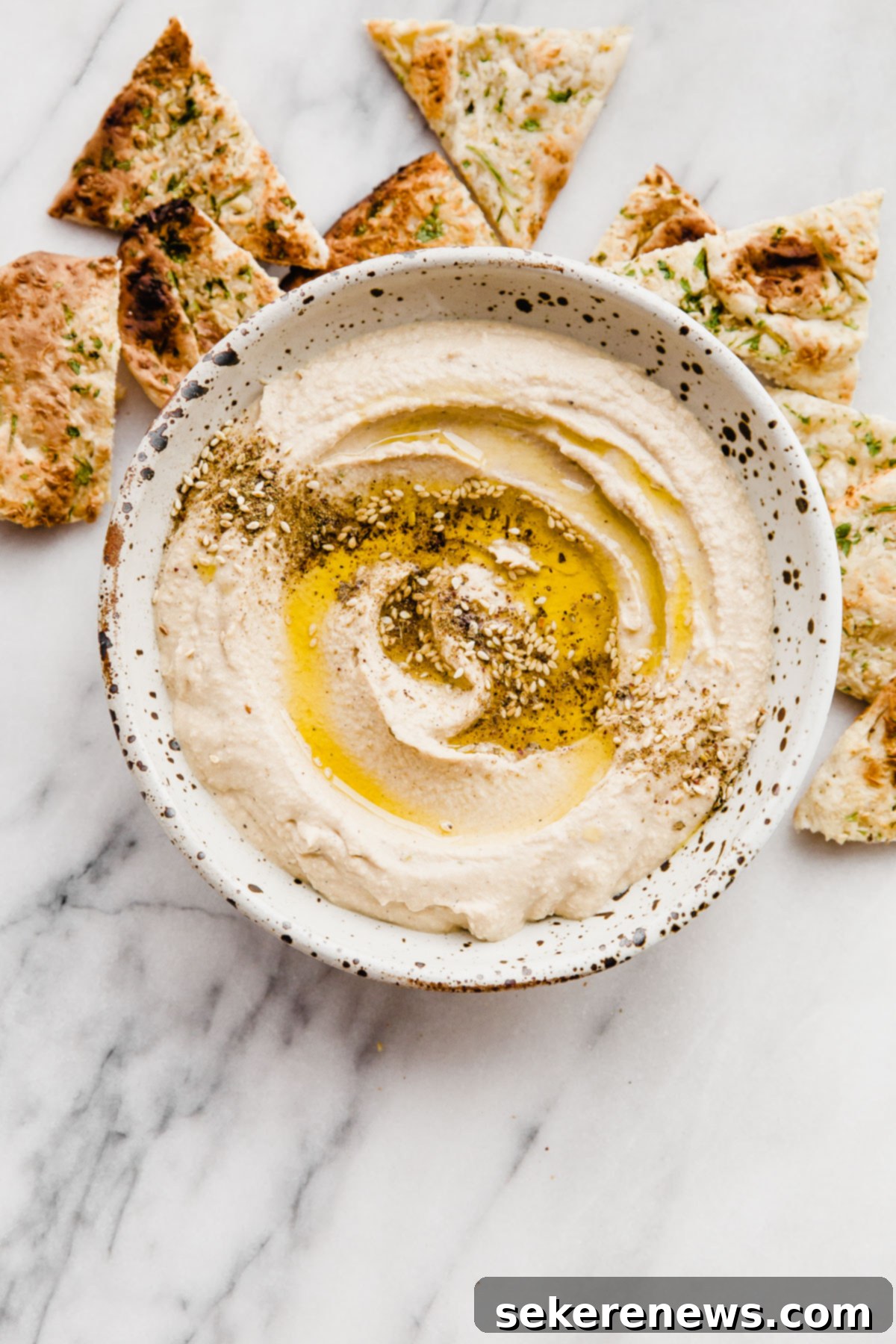The Ultimate Guide to Easy Homemade Hummus: Creamy Recipe, Tips & Flavor Variations
Welcome to the ultimate guide for making the world’s easiest, creamiest, and most delicious homemade hummus! This recipe transforms simple canned chickpeas into a luscious dip in mere minutes, perfect for any occasion. Plus, we’re sharing our absolute favorite roasted garlic serrano chile variation for those who crave a little extra depth and a touch of heat. Get ready to elevate your snack game with minimal effort and maximum flavor.
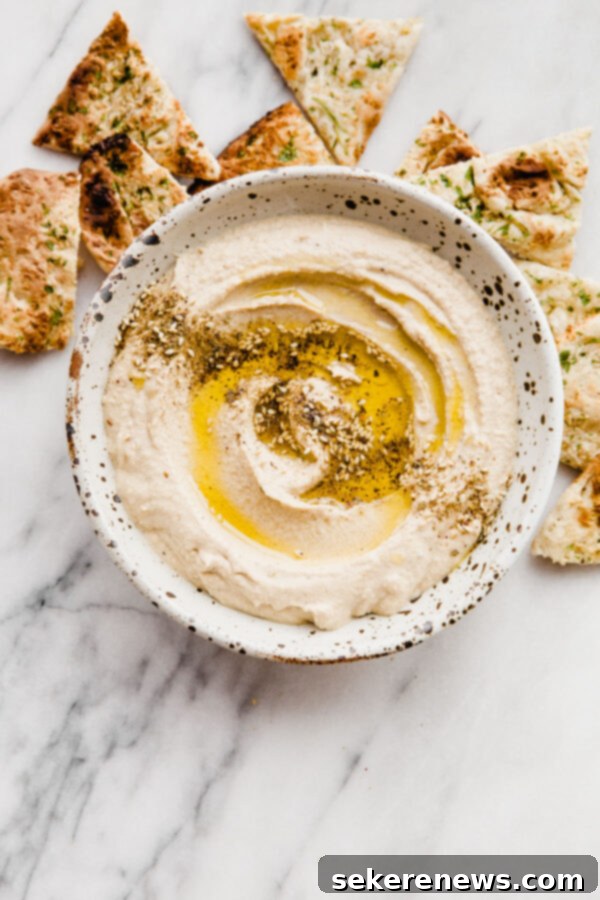
I am thrilled to share with you a recipe that will become an instant favorite: my supremely easy homemade hummus. Forget complicated steps or lengthy preparation times; today, we’re keeping things blissfully simple. This isn’t just another hummus recipe; it’s a game-changer for anyone looking for a quick, healthy, and incredibly flavorful dip or appetizer that everyone will love.
While homemade hummus might not sound like a revolutionary idea, I’ve been perfecting my version for quite some time, and it truly stands out. This easy hummus recipe has become a constant in our household. It never lasts long in the fridge, a testament to its irresistible taste and versatility. If you’re looking for a crowd-pleasing snack for yourself or friends and family, keep this simple hummus recipe in your back pocket. Hummus is one of my ultimate go-to appetizers because it’s not only incredibly healthy, packed with protein and fiber, but it also delivers fantastic flavor with minimal effort.
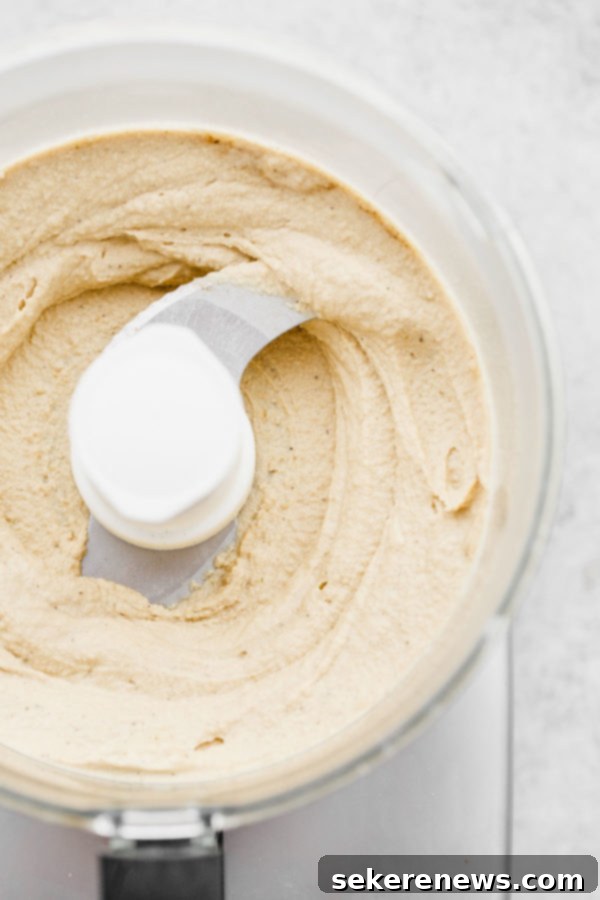
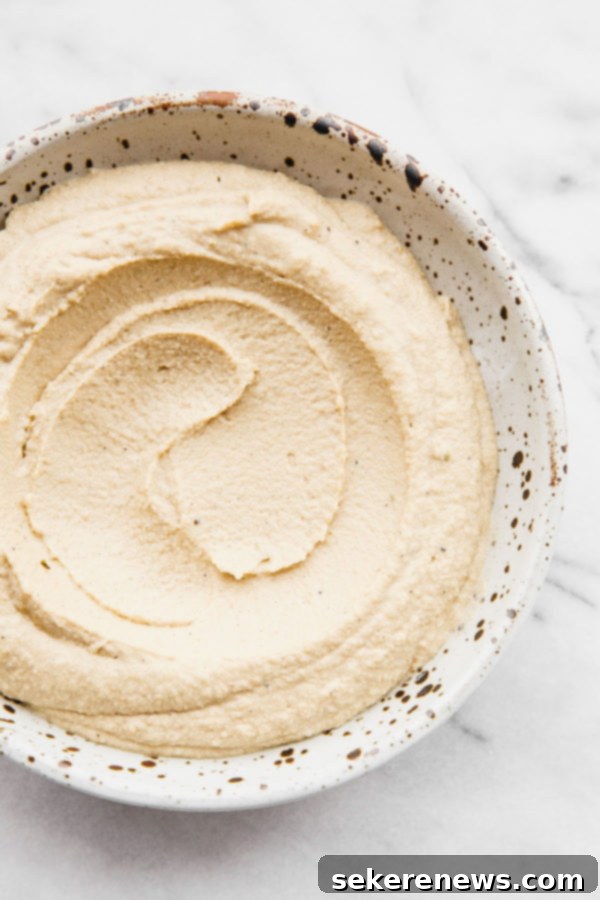
Why Homemade Hummus is Always Better (and Easier!)
While I’m certainly not above grabbing a tub of hummus from the grocery store in a pinch, making your own at home offers significant advantages that truly set it apart. For starters, it’s far more affordable than repeatedly buying pre-made versions, especially if hummus is a regular in your diet. But beyond the cost savings, homemade hummus delivers an unparalleled freshness and vibrancy of flavor that store-bought simply cannot match. The best part? This easy recipe takes less than 10 minutes to whip up, and you have complete control over the ingredients, allowing you to customize and tweak it to your exact taste. This means you can adjust the tanginess, the garlic kick, the salt level, and even mix up the flavors with various delightful add-ins.
Unleash Your Creativity: Make Your Own Hummus Flavors
One of the greatest joys of making hummus from scratch is the freedom to experiment with different flavor profiles. While a classic, simple hummus is delicious on its own, adding a twist can transform it into something truly extraordinary. My personal favorite variation, which I highly recommend trying, incorporates dry-roasted garlic and a serrano chile. This combination infuses the hummus with a subtle touch of heat and a wonderfully smoky depth that is simply divine. It’s an easy way to elevate your homemade hummus from great to unforgettable.
Dry roasting is a simple yet incredibly effective technique where you char ingredients in a dry skillet over the stove without any oil. In this particular variation, we’ll be charring unpeeled garlic cloves – the skin acts as a protective layer, preventing them from burning too quickly – and a single serrano chile. This process might add an extra 10 to 15 minutes to your prep time, but believe me, the resulting complex flavors are well worth the wait. The roasted garlic becomes sweet and mellow, while the serrano chile develops a delicate smokiness, adding a nuanced warmth to your creamy hummus. I also love to finish my hummus with a generous drizzle of high-quality extra virgin olive oil and a sprinkle of vibrant za’atar spice, adding another layer of aromatic complexity that truly makes it sing.
Below, you’ll find comprehensive instructions for both the classic, simple hummus recipe and the specific steps and ingredients required for this irresistible roasted garlic-serrano chile variation. Get ready to impress yourself and your guests with this elevated homemade dip!
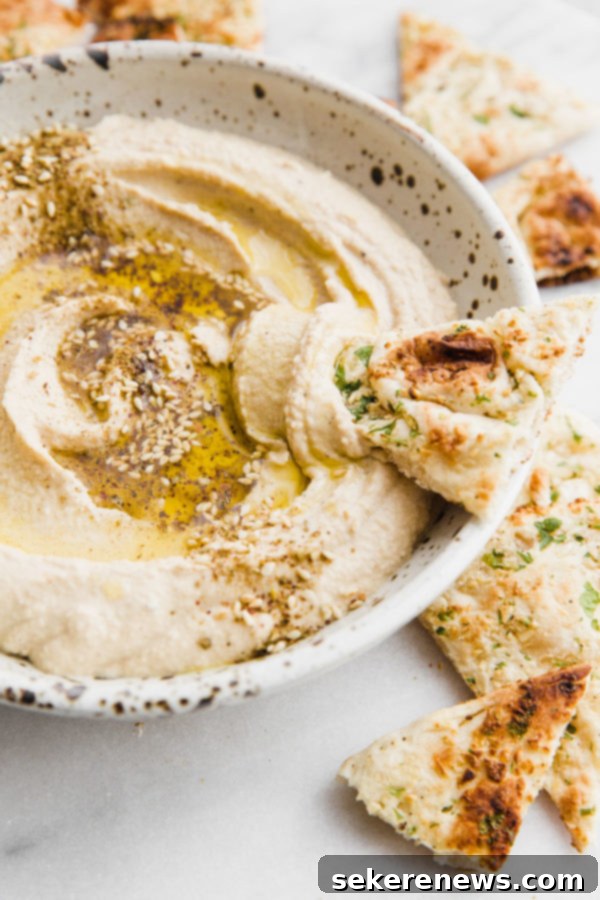
Mastering the Art of Hummus: How to Make It
Crafting this incredible, creamy hummus requires surprisingly few ingredients, most of which you likely already keep on hand. This convenience means you can whip up a fresh batch at a moment’s notice, eliminating the need for an unplanned trip to the grocery store. It’s truly a recipe designed for ease and delicious spontaneity, making homemade hummus a regular possibility.
For my version of this easy hummus recipe, we’re embracing efficiency and opting for canned chickpeas rather than soaking and cooking dried ones from scratch. While traditionalists might argue that cooking dried chickpeas yields a slightly superior hummus with a marginally smoother texture, the reality of modern life often calls for recipes that can be prepared with minimal fuss and planning. Canned chickpeas are a fantastic shortcut that still produces an exceptionally creamy and flavorful result, making homemade hummus accessible to everyone, even on busy weeknights. The convenience they offer is simply unmatched for a quick, healthy dip.
Essential Ingredients for Your Perfect Hummus:
To create a truly delicious, authentic-tasting hummus, the quality and preparation of your ingredients matter. Here’s a closer look at what you’ll need and why each component is vital:
- Canned Chickpeas (Garbanzo Beans): These form the creamy base of our hummus. It’s crucial to drain and rinse them exceptionally well to remove excess sodium and any canning liquid, which can impact the final flavor. Using canned chickpeas simplifies the process immensely, making this an incredibly fast and easy hummus recipe.
- Pure Tahini Paste: This is arguably the most important component in authentic hummus, imparting its signature creamy texture, nutty depth, and distinct flavor. Do not skimp on quality here! I always keep a jar of good tahini in my fridge, not just for hummus, but also for creating delicious salad dressings and sauces, such as my easy lemon tahini sauce, which complements a wide variety of dishes. While Soom is my top recommendation for its superior flavor and smooth consistency, use the best quality brand available to you for the creamiest result.
- Fresh Garlic: The choice between raw or dry-roasted garlic depends entirely on your flavor preference and the desired intensity. Raw garlic provides a sharp, pungent kick, offering a bold garlic flavor, while roasted garlic (as in our special variation) offers a mellower, sweeter, and more complex aroma, softening the garlic’s bite.
- Fresh Lemon Juice: The bright, zesty acidity of fresh lemon juice is absolutely crucial for balancing the richness of the tahini and chickpeas, adding that essential lift and tang to your hummus. I personally enjoy a hummus with a pronounced lemon-forward flavor, but feel free to adjust the amount to suit your own palate. Always use fresh lemon juice for the best results; bottled juice simply doesn’t compare in terms of brightness and flavor.
- Extra Virgin Olive Oil: Essential for both flavor and richness, a good quality extra virgin olive oil adds a fruity, peppery note and contributes to the overall luxurious texture of the hummus. It also makes a beautiful, glossy drizzle for serving, enhancing the visual appeal and taste.
- Kosher Salt and Freshly Ground Black Pepper: These pantry staples are key to seasoning your hummus perfectly. Start with the recommended amounts and adjust to taste. Don’t be shy about seasoning; a proper balance of salt and pepper brings all the other flavors to life.
- Ice Cold Water: This is the secret ingredient for achieving an incredibly smooth and creamy hummus, especially when using canned chickpeas and skipping the peeling step. I prefer my hummus on the thinner, looser side, which is more traditional for many Middle Eastern preparations. Adding ice cold water during blending helps create a lighter, silkier texture and significantly improves the overall mouthfeel without the arduous task of peeling individual chickpeas. This small trick makes a huge difference in the final texture of your homemade hummus.
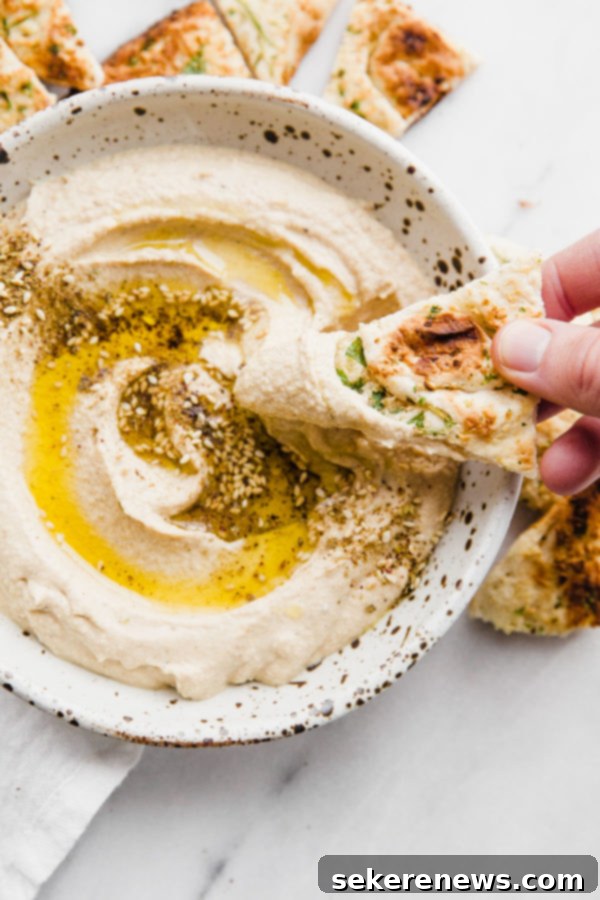
The Great Chickpea Debate: Is Peeling the Chickpeas Worth It?
For a long time, I used to believe wholeheartedly that peeling the chickpeas was a non-negotiable step for achieving truly smooth hummus. If you’re unfamiliar, this painstaking process involves gently rubbing each chickpea between your fingers to remove its thin, papery skin. It’s a method often recommended for an ultra-silky texture, but it can be incredibly time-consuming and frankly, a bit of a chore.
While it’s true that peeled chickpeas will result in a marginally smoother textured hummus, I’ve discovered a fantastic shortcut that yields equally impressive results without the tedious effort: the power of ice-cold water. My method, utilizing ice-cold water during the blending process, allows you to create an exceptionally smooth and creamy hummus that rivals its peeled counterparts. This revelation has saved me countless hours and a great deal of sanity! Plus, let’s not forget that chickpea skins are an excellent source of dietary fiber, so keeping them in is actually beneficial for your health. So, embrace the ease, save time, and enjoy the added nutrients!
To successfully make this creamy, easy hummus, a good-quality food processor or a high-powered blender, such as a Vitamix, is absolutely essential. These powerful appliances are necessary to break down the chickpeas and emulsify all the ingredients into a perfectly smooth, luxurious dip. Once your homemade hummus is ready, the serving possibilities are truly endless! Enjoy it with a vibrant assortment of raw vegetables (carrots, cucumbers, bell peppers), sturdy rice crackers, warm toasted naan bread, or fluffy pita. It’s also a fantastic base for more elaborate dishes, such as this delectable spicy hummus avocado toast with feta, delightful Greek-Style potato skins, or as a flavorful accompaniment to homemade falafel bites. The versatility of homemade hummus makes it a staple in any kitchen.
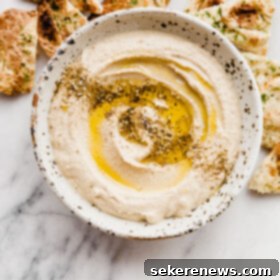
How to Make Hummus
Pin
Review
SaveSaved!
Equipment
-
Magimix Food Processor
Ingredients
Optional Add’Ins:
- 3 medium garlic cloves, unpeeled optional (*if you’re not choosing not to dry-roast the garlic, substitute with only 1 finely grated clove)
- 1 serrano pepper optional
Hummus:
- 1 can (15-ounce) garbanzo beans (chickpeas) drained and rinsed well
- ⅓ cup tahini paste I recommend Soom brand
- 3-4 tablespoons fresh lemon juice adjust to taste
- 1 tablespoon extra virgin olive oil
- ¾ teaspoon kosher salt
- ¼ teaspoon ground black pepper
- 2-3 tablespoons ice cold water as needed, to your texture preference
For Serving:
- extra virgin olive oil for drizzling
- 1 teaspoon za’atar spice blend or sumac for sprinkling on top
- toasted sesame seeds optional
Instructions
-
If making the roasted garlic and serrano pepper variation: Place the unpeeled garlic cloves and serrano chile in a small skillet and place over medium heat. Dry roast the garlic cloves and chile for 10 to 12 minutes (it will take about 5 minutes to notice anything happening), flipping them once or twice, until they are charred black in some spots. Remove the chile and place on a cutting board. Continue dry roasting the garlic cloves for an additional 3 to 5 minutes, or until they are charred in spots and they are beginning to soften. Transfer to the cutting board with the chiles and allow to cool slightly before handling.
-
Trim the stem and slice the serrano chile in half lengthwise. Gently scrape out and discard the seeds and ribs (see notes section). Remove and discard the skins of the garlic cloves. The unpeeled garlic cloves should be charred, fragrant, and slightly soft.
-
Place the drained chickpeas, peeled roasted garlic cloves (or 1 finely grated garlic clove, if substituting), roasted serrano chile (if using), tahini paste, lemon juice, olive oil, kosher salt, and black pepper in the bowl of a large food processor. Puree until smooth, scraping down the sides of the bowl with a spatula several times to ensure all of the ingredients are incorporated evenly. Continue pulsing as you add the ice cold water, mixing until the desired texture is reached (I prefer a looser hummus). Season to taste, adding additional salt and pepper as needed.
-
Spoon the hummus into a large bowl, using the back of a large spoon to create a large divet and swirl on the surface. Just before serving, garnish with a generous drizzle of extra virgin olive oil and sprinkle with za’atar spice or sumac. Top with toasted sesame seeds if desired. Serve.
Leftover hummus can be stored in a covered container in the fridge for up to 5 days. It will thicken in the fridge, but you can loosen it by stirring in a small splash of water as desired. Re-season with salt as needed.
Tips for the Creamiest Hummus Every Time
Achieving that perfectly smooth, silky hummus texture is simpler than you think, especially with canned chickpeas. Beyond the ice-cold water trick, here are a few more pro tips to ensure your homemade hummus is consistently excellent and incredibly creamy:
- Blend for Longer: Don’t be afraid to let your food processor run for a few minutes. The longer you blend, the creamier and airier your hummus will become. Continuous blending helps break down the chickpeas thoroughly. Remember to scrape down the sides of the bowl frequently with a spatula to ensure all ingredients are evenly incorporated and processed.
- Adjust Liquid Gradually: While ice-cold water is key for texture, add it slowly, one tablespoon at a time, until you reach your desired consistency. Some prefer a thicker hummus for spreading on sandwiches, while others like a looser, more pourable dip. The consistency is entirely up to your personal preference.
- Taste and Adjust Seasoning: Always taste your hummus before serving. Lemon juice, salt, and pepper can and should be adjusted to your personal preference. If it tastes a bit flat, a pinch more salt or a fresh squeeze of lemon can work wonders to brighten and balance the flavors.
- Emulsify with Olive Oil: Drizzling a little extra virgin olive oil over the top before serving isn’t just for beautiful presentation; it adds a final touch of richness, gloss, and flavor that beautifully complements the other ingredients, creating a more decadent mouthfeel.
- Consider Your Tahini: As mentioned, tahini quality is paramount for the best hummus. A good, light-colored tahini made from roasted sesame seeds will yield a much smoother and less bitter hummus. If your tahini is very thick, you might need to add a little extra ice water to achieve the desired consistency.
Creative Hummus Flavor Variations to Explore
Once you’ve mastered the classic, easy hummus recipe, the world of hummus variations opens up! Homemade hummus is incredibly versatile, making it perfect for endless experimentation. Here are some inspiring ideas to spark your culinary creativity:
- Roasted Red Pepper Hummus: Roast a red bell pepper until softened and charred (you can do this in the oven or on a stove burner), then peel and add it to your food processor along with the other ingredients. It adds a sweet, smoky depth and a beautiful, vibrant red color to your creamy hummus.
- Sun-Dried Tomato Hummus: Incorporate a few oil-packed sun-dried tomatoes (drained well) into your blend for a rich, tangy, and intensely savory twist that pairs wonderfully with Italian-inspired dishes.
- Spicy Sriracha or Chipotle Hummus: For a bold and fiery kick, add a teaspoon or two of sriracha sauce or a canned chipotle pepper in adobo sauce to your mixture. Adjust the amount to your desired level of heat.
- Pesto Hummus: Blend in a couple of tablespoons of fresh basil pesto for an herbaceous, garlicky, and vibrant green dip that’s bursting with fresh flavors.
- Avocado Hummus: Add half an ripe avocado to the mix for an extra creamy texture and a subtle, rich flavor. This variation is super fresh and delicious, especially when garnished with cilantro.
- Caramelized Onion Hummus: Slowly caramelize sliced onions until deeply golden brown and sweet, then blend them into your hummus for an incredibly savory and comforting flavor that is truly irresistible.
- Spinach & Artichoke Hummus: Combine cooked spinach and chopped artichoke hearts with your base hummus recipe for a dip reminiscent of the classic appetizer, but healthier!
Serving & Storage Tips for Your Homemade Hummus
Your freshly made hummus is ready to be enjoyed in countless ways! Here’s how to serve it best and keep it fresh for as long as possible:
- Serving Suggestions:
- Classic Pairing: Serve with warm, fluffy pita bread, fresh vegetable sticks (like crisp cucumber, crunchy carrot, vibrant bell pepper strips, and juicy cherry tomatoes).
- Elevated Appetizers: Pair your hummus with gourmet crackers, toasted artisan bread slices, or alongside marinated olives and creamy feta cheese for a more sophisticated spread.
- Meal Accompaniment: Use it as a healthy and flavorful spread in sandwiches and wraps, as a creamy base for trendy avocado toast, or a nutritious dollop with grilled chicken, fish, or homemade falafel.
- Garnishes: Always finish your hummus with a generous drizzle of good extra virgin olive oil – it adds both flavor and a beautiful sheen. A sprinkle of aromatic za’atar spice blend, tangy sumac, vibrant paprika, or finely chopped fresh parsley adds visual appeal and extra layers of flavor. Toasted pine nuts or sesame seeds are also excellent, adding a delightful crunch.
- Storage:
- Refrigeration: Store any leftover homemade hummus in an airtight container in the refrigerator for up to 5 days. Ensure the container is well-sealed to maintain freshness.
- Reviving Texture: The hummus will naturally thicken slightly in the fridge. If you prefer a looser, creamier consistency, simply stir in a small splash of ice-cold water or a tiny bit of olive oil before serving. Always taste and re-season with a pinch of salt if needed, as flavors can mellow over time.
- Freezing: For longer storage, hummus can be frozen for up to 1 month. Place it in an airtight, freezer-safe container, leaving a little room for expansion. Thaw the hummus in the refrigerator overnight when ready to use, and stir it well before serving, adding a little water or olive oil to restore its original creamy texture.
